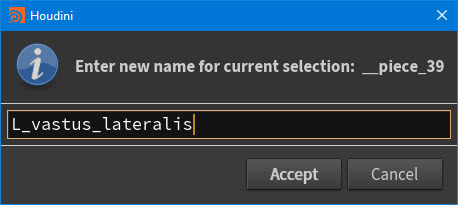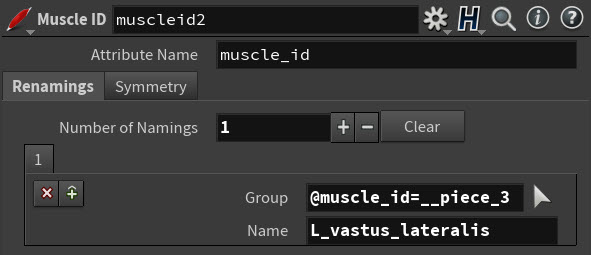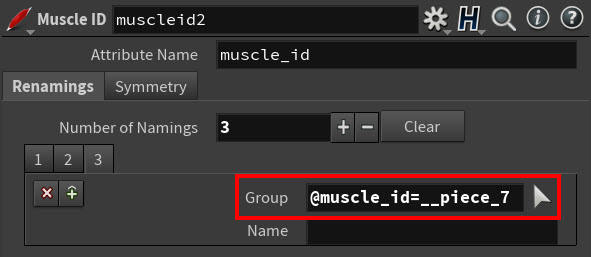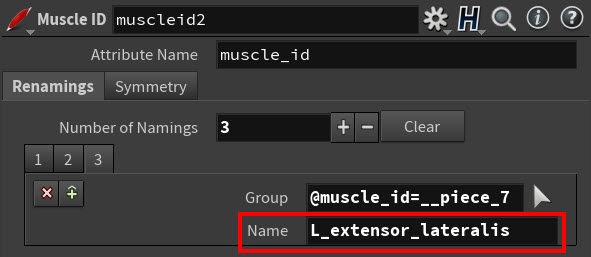| On this page | |
| Since | 19.0 |
このノードは、入力ジオメトリ内の繋がったプリミティブの集合体毎にMuscle IDを作成して割り当てます。
既にmuscle_id文字列Primitiveアトリビュートが入力ジオメトリ上に存在する場合、このノードでmuscle_idPrimitiveアトリビュートの名前を変更して文字列値を修正することもできます。
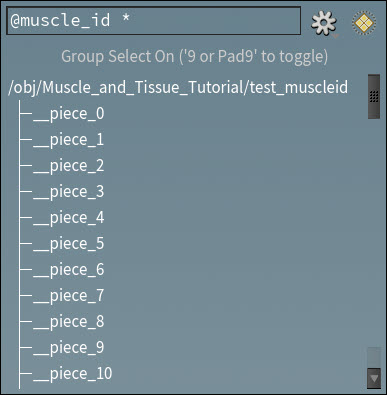
Muscle IDは、下流のMuscle & Tissue系ノードで入力ジオメトリ上の 各Muscleを区別 する際に使用されます。
デフォルトでは、入力ジオメトリ内の繋がったプリミティブの集合体毎に一時的な初期Muscle ID値が割り当てられます。
例えば、__piece_0, __piece_1, __piece_02などです。
Renamingsマルチパラメータを使用してジオメトリのMuscle ID値を更新することができます。
How-to
| To... | Do this |
|---|---|
|
ビューポートステートからMuscleの名前を変更する |
|
|
パラメータエディタからMuscleの名前を変更する |
|
ステート ¶
ホットキーまたは操作 |
アクション |
|---|---|
= |
選択したMuscleにMuscle ID値を設定します。 |
- |
選択したMuscleの現在のMuscle ID値をクリアします。 |
0 |
入力のMuscleジオメトリからすべてのMuscle ID値をクリアします。 |
9 |
Select Groups or Connected Geometry 選択モードを有効にして、ビューポート内に Group and Attribute List を表示します。 |
視覚的フィードバック |
意味 |
|---|---|
灰色のMuscle |
デフォルトのMuscle ID値が設定されたMuscle。 |
金色のMuscle |
現在選択されているMuscleジオメトリ。 |
赤色のMuscle |
Muscle ID値の名前が変更されたMuscle。 
|
アトリビュート ¶
|
|
string |
|
パラメータ ¶
Attribute Name
このノードが生成するMuscle IDアトリビュートの名前。
Muscle IDアトリビュートを別の名前に定義したいのであれば、このパラメータを使用して新しい名前を指定することができます。
例えば、muscle_idをmuscle_nameに変更することができます。
Default Name
入力ジオメトリの繋がったピース毎に付ける初期接頭辞文字列。 このデフォルト名の後に連番が追加され、それがMuscle IDアトリビュートに割り当てられます。
Renamings ¶
Renamings マルチパラメータでは、名前を変更したいMuscleジオメトリピースとそのジオメトリピースに割り当てたい新しいMuscle ID値を指定することができます。
Number of Namings
-
Muscleの数。この数は、対称なMuscleの複製を 含みません 。
-
Renamings マルチパラメータを追加または削除します。
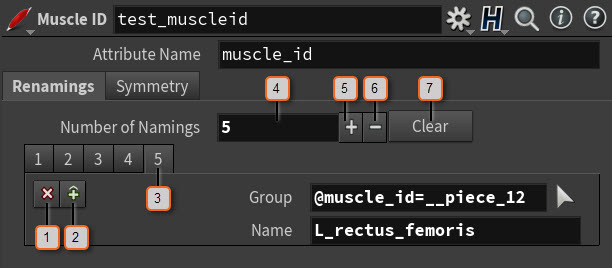
1 - 現在選択されているマルチパラメータタブを削除します。
2 - 現在選択されているマルチパラメータタグの右側に新しいマルチパラメータタブを挿入します。
3 - 現在選択されているマルチパラメータタブ。
4 - リストの最後にマルチパラメータタブを追加または削除します。この数を上げるとタブが追加され、下げるとタブが削除されます。
5 - リストの最後にマルチパラメータタブを追加します。
6 - リストの最後からマルチパラメータタブを削除します。
7 - 現在のマルチパラメータタブをすべて削除します。
Group
指定した Name (Muscle ID値)が割り当てられるプリミティブ、プリミティブの範囲、ジオメトリグループ、デフォルトの@muscle_idを決めます。
例えば、13929, 13929-13932, group_10, @muscleid=__piece_01です。
Name
定義した Group のmuscle_id文字列値を指定します。
クリーチャまたはキャラクタのモデルが 対称 である場合、値の(左側または右側)に適切な 接頭辞 も含めてください。
例えば、L_gastronemiusとかl_obliqueです。

Mirror Group
@muscle_id構文を使って定義した Group を持つ対称モデルに関しては、このフィールドは、現在のSymmetry設定で自動的に決定されたミラーグループ定義を表示します。
別の方法を使って定義した Group を持つ対称モデルに関しては、このフィールドを使用して適切なミラーグループ定義を指定することができます。
Mirror Group は、Expose Renaming Parameterが 有効 な場合にのみアクセス可能です。
Mirror Name
@muscle_id構文を使って定義した Group を持つ対称モデルに関しては、このフィールドは、現在のSymmetry設定で自動的に生成されたミラーMuscle ID値を表示します。
別の方法を使って定義した Group を持つ対称モデルに関しては、このフィールドを使用してミラーMuscle ID値を指定することができます。
Mirror Name は、Expose Renaming Parameterが 有効 な場合にのみアクセス可能です。

Symmetry ¶
対称モデルの最初の半分に対して Group 値と Name 値を定義すると、 Symmetry パラメータは、その反対側半分に対して Mirror Group 値と Mirror Name 値を自動的に決定して生成します。
自動対称は、@muscle_id構文を使ってGroup値を指定した場合にのみ動作します。
(プリミティブの範囲やジオメトリグループなどの)別の方法を使用した場合、手動でMuscleの Mirror Group 値と Mirror Name 値を入力する必要があります。
自動対称は、全体が完全に対称なモデルにのみ適用可能です。
入力のMuscleジオメトリが対称モデルの 片側 しかない場合、 Muscles & Tissueネットワーク内の下流で
Mirror Muscles SOPを使用することで、すべてのMuscleに適切なMuscle ID値を割り当てることができます。
Apply Symmetry
有効にすると、(モデルが片側しかない場合ではなく)モデル全体が完全に対称な場合、 Group と Name を使用してMuscleに名前を付けると、モデルの反対側のMuscleには、 Mirror Parameters 設定で定義されたルールを使用して自動的に名前が付きます。
Apply Symmetryは、 Group パラメータにプリミティブまたはプリミティブの範囲が含まれている場合には 動作しません 。
これは、上流で Group SOPノードのどれかを使用してセットアップしたグループが Group パラメータに含まれている場合にのみ動作します。
Mirror Parameters は、 Apply Symmetry が 有効 な場合にのみ利用可能です。
Expose Renaming Parameter
有効にすると、 Mirror Group パラメータと Mirror Name パラメータが各 Renamings マルチパラメータに出現します。
From Prefix
Name 値で使用される名前の接頭辞を指定します。
例えば、 Name 値がL_gastronemiusとかL_obliqueならば、このパラメータ値にはL_を指定します。
To Prefix
自動的に生成されたすべての Mirror Name 値に含まれている From Prefix を置換する名前の接頭辞を指定します。
例えば、 From Prefix のパラメータ値がL_ならば、R_gastronemiusとかR_obliqueにするために To Prefix パラメータ値をR_にしてください。
Origin
Muscleの原点を基準としたミラー平面のXYZ位置。
Distance
Origin からのミラー平面の距離オフセット。
Direction
Muscleを対称化させる平面(X, Y, Z)。 また、そのミラー平面の法線方向を決めます。
入力 ¶
-
Muscleには交差のないポリゴンマニフォールドジオメトリが理想です。
-
Muscleジオメトリデータは色々なソースから取得することができます。
例:
-
Muscle & Tissueネットワークと同じHIPファイル内に配置されたジオメトリSOPノード。
-
Muscleジオメトリデータが含まれた
Stash SOPノード。
-
Muscleジオメトリデータが含まれた
.abcファイルを読み込むAlembic SOPノード。
-
Muscleジオメトリデータが含まれたディスク上の
.bgeoを参照したFile SOPノード。
-
出力 ¶
Muscle & Tissueネットワーク内のMuscleを表現した繋がったプリミティブの集合体毎のmuscle_id。
| See also |
